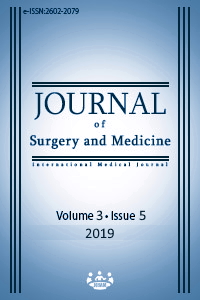Approach to iatrogenic colon perforations due to colonoscopy: A retrospective cohort study
Keywords:
Colonoscopy, Iatrogenic colon perforation, Treatment, Emergent surgery, LaparoscopyAbstract
Aim: Iatrogenic colonic perforation (ICP) is a serious complication that can increase mortality and morbidity in patients undergoing therapeutic or diagnostic colonoscopy. The aims of this study are to (1) evaluate the underlying mechanisms of ICPs; (2) discuss the ideal treatment approach and period between onset and treatment; (3) review the current literature regarding the management of ICPs and (4) share our experiences as a single tertiary center.
Methods: Patients who underwent colonoscopy between January 2012 and March 2019 at Kanuni Sultan Süleyman Training and Research Hospital’s Endoscopy Unit were reviewed retrospectively. Interventions during which ICPs occurred were documented and analyzed.
Results: Between January 2012 and March 2019, 9857 patients underwent colonoscopy and 1320 patients underwent rectosigmoidoscopy at our center. Ten of these procedures were associated with perforation. The perforation rates were 0.06% and 0.23% in diagnostic and therapeutic colonoscopies respectively. The most frequent localizations of perforation were (a) Rectosigmoid junction (30%) (b) Sigmoid colon (30%) (c) Descending colon (20%) and (d) Transvers colon (10% (e) Cecum (10%). Managements included surgical treatment in eight patients two of whom were operated with late laparotomy, endoscopic clipping of perforation and conservative management in one patient, and conservative treatment in one patient. There was no mortality and eight patients discharged uneventfully but one of remaining two patients had acute hepatitis, one had enterocutaneous fistula. Conclusion: Iatrogenic colonic perforations are rare but most serious complications of colonoscopy procedures. Especially, special attention should be given to older and comorbid patients receiving therapeutic procedures during colonoscopy. High risk patients and their families must be informed about this complication. Difficult and tough colonoscopies should be monitored closely at least 24 hours as early diagnosis is vital for treatment. Comorbidities, age, general condition of patient, the size and location of the perforation, and the time interval between onset and diagnosis should be evaluated, and the treatment procedure should be planned. Conservative management, endoscopic clipping, laparoscopic or open operations from primary repair to Hartmann’s procedure can be used, decision should be made on a case by case basis.
Downloads
References
Fisher DA, Maple JT, Ben-Menachem T, Cash BD, Decker GA. ASGE Standards of Practice Committee. Complications of colonoscopy. Gastrointest Endosc. 2011;74:745–52.
Araghizadeh FY, Timmcke AE, Opelka FG, Hicks TC, Beck DE. Colonoscopic perforations. Dis Colon Rectum. 2001;44:713–6. https://doi.org/10.1007/BF02234572.
Hall C, Dorricott NJ, Donovan IA, Neoptolemos JP. Colon perforation during colonoscopy: surgical versus conservative management. Br J Surg. 1991;78:542–4.
Samalavicius NE, Kazanavicius D, Lunevicius R, Poskus T, Valantinas J, Stanaitis J, et al. Incidence, risk, management, and outcomes of iatrogenic full-thickness large bowel injury associated with 56,882 colonoscopies in 14 Lithuanian hospitals. Surg Endosc. 2013;27:1628–35. doi: 10.1007/s00464-012-2642-4.
Luning TH, Keemers-Gels ME, Barendregt WB, Tan AC, Rosman C. Colonoscopic perforations: a review of 30,366 patients. Surg Endosc. 2007;21:994–7. doi: 10.1007/s00464-007-9251-7.
Iqbal CW, Chun YS, Farley DR. Colonoscopic perforations: a retrospective review. J Gastrointest Surg. 2005;9:1229–35: discussion 1236.
Kang HY, Kang HW, Kim SG, Kim JS, Park KJ, Jung HC, et al. Incidence and management of colonoscopic perforations in Korea. Digestion. 2008;78:218–23.
Hamdani U, Naeem R, Haider F, Bansal P, Komar M, Diehl DL, et al. Risk factors for colonoscopic perforation: A populationbased study of 80118 cases. World J Gastroenterol. 2013;19:3596-601.
Arora G, Mannalithara A, Singh G, Gerson LB, Triadafilopoulos G. Risk of perforation from a colonoscopy in adults: a large population-based study. Gastrointest Endosc. 2009;69:654-64.
Gatto NM, Frucht H, Sundararajan V, Jacobson JS, Grann VR, Neugut AI. Risk of perforation after colonoscopy and sigmoidoscopy: a population-based study. J Natl Cancer Inst. 2003;95:230-6.
Sagawa T, Kakizaki S, Iizuka H, Onozato Y, Sohara N, Okamura S, et al. Analysis of colonoscopic perforations at a local clinic and a tertiary hospital. World J Gastroenterol. 2012;18(35):4898–904. doi:10.3748/wjg.v18.i35.4898
Christie JP, Marrazzo J. 3rd “Mini-perforation” of the colon--not all postpolypectomy perforations require laparotomy. Dis Colon Rectum. 1991;34:132–5. [PubMed]
Lo AY, Beaton HL. Selective management of colonoscopic perforations. J Am Coll Surg. 1994;179:333–7.
Taku K, Sano Y, Fu KI, Saito Y, Matsuda T, Uraoka T, et al. Iatrogenic perforation associated with therapeutic colonoscopy: a multicenter study in Japan. J Gastroenterol Hepatol. 2007;22:1409–14.
Mattei P, Alonso M, Justinich C. Laparoscopic repair of colon perforation after colonoscopy in children: report of 2 cases and review of the literature. J Pediatr Surg. 2005;40:1651–53.
Zhang YQ, Lu W, Yao LQ, Qin XY, Xu MD, Zhong YS, et al. Laparoscopic direct suture of perforation after diagnostic colonoscopy. Int J Colorectal Dis. 2013;28:1505–9.
Bleier JI, Moon V, Feingold D, Whelan RL, Arnell T, Sonoda T, Milsom JW, et al. Initial repair of iatrogenic colon perforation using laparoscopic methods. Surg Endosc. 2008;22:646–9.
Kim JS, Kim BW, Kim JI, Kim JH, Kim SW, Ji JS, et al. Endoscopic clip closure versus surgery for the treatment of iatrogenic colon perforations developed during diagnostic colonoscopy: a review of 115,285 patients. Surg Endosc. 2013;27:501–4.
Jovanovic I, Zimmermann L, Fry LC, Mönkemüller K. Feasibility of endoscopic closure of an iatrogenic colon perforation occurring during colonoscopy. Gastrointest Endosc. 2011;73:550–5.
Trecca A, Gaj F, Gagliardi G. Our experience with endoscopic repair of large colonoscopic perforations and review of the literature. Tech Coloproctol. 2008;12:315–21. discussion 322.
Taku K, Sano Y, Fu KI, Saito Y, Matsuda T, Uraoka T, et al. Iatrogenic perforation associated with therapeutic colonoscopy: a multicenter study in Japan. J Gastroenterol Hepatol. 2007;22:1409–14.
Dafnis G, Ekbom A, Pahlman L, Blomqvist P. Complications of diagnostic and therapeutic colonoscopy within a defined population in Sweden. Gastrointest Endosc. 2001;54:302-9.
Lohsiriwat V. Colonoscopic perforation: incidence, risk factors, management and outcome. World J Gastroenterol. 2010;16:425-30.
Downloads
- 1145 2088
Published
Issue
Section
How to Cite
License
Copyright (c) 2019 Yasin Kara
This work is licensed under a Creative Commons Attribution-NonCommercial-NoDerivatives 4.0 International License.
















